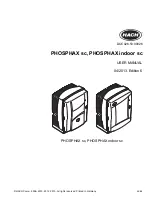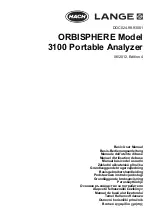
the operation of the input attenuators
(14)
can
be tested at a level of -27dBm. The spec-tral
line visible on the screen can be reduced in 4
steps of 10dB each by activating the
attenuators incorporated in the spectrum
analyzer. Each 10dB step corresponds to one
graticule division on the screen. The tolerance
may not exceed
1dB in all attenuation
positions.
Prior to calibration ensure that all input
attenuator switches
(14)
are released. The
AT6010/AT6011 must be operated for at least
60 minutes prior to calibration. The
VIDEO
FILTER
push button
(11)
must be in
OFF
position, the BANDWIDTH (10) must be set
to 400KHz, and
SCANWIDTH (15)
set to
100KHz/div. After the center frequency is set
to 500MHz, a generator signal must be applied
to the input. The output level should level
should be between 40 and 50 dB above the
noise.
C:
Set generator frequency to
500MHz
.
Adjust the peak of the 500MHz spectral line to
the horizontal screen center using the
X-POS.
control
(16)
.
D:
Set the generator frequency to
100MHz
.
If
the 100MHz spectral line is not on the 2nd.
graticule line from left, it should be aligned
using the
X-AMPL
. Control
(17)
. Then the
calibration as de-scribed under be verified and
corrected if necessary. The calibrations
C
and
D
should be repeated until optimum
adjustment is achieved.
Horizontal Calibration
Introduction to
Spectrum Analysis
The analysis of electrical signals is a
fundamental problem for many engineers and
scientists. Even if the immediate problem is
not electrical, the basic parameters of interest
are often changed into electrical signals by
means of transducers. The rewards for
transforming physical parameters to electrical
signals are great, as many instruments are
available for the analysis of electrical signals
in the time and frequency domains.
The traditional way of observing electrical
signals is to view them in the time domain
using an oscilloscope. The time domain is
used to recover relative timing and phase
information which is needed to characterize
electric circuit behavior. However, not all
circuits can be uniquely characterized from
just time domain information. Circuit elements
such as amplifiers, oscillators, mixers,
modulators, detectors and filters are best
characterized by their frequency response
information. This frequency informat5ion
is best obtained by viewing electrical signals
in the frequency domain. To display the
frequency domain requires a device that can
discriminate between frequencies while
measuring the power level at each. One
instrument which displays the frequency
domain is the spectrum analyzer. It graphically
displays voltage or power as a function of
frequency only on a CRT
(cathode ray tube)
.
In the time domain, frequency components of
a signal are seen summed together. In the
frequency domain, complex signals
(i.e.
Signals composed of more than one frequency)
are separated into their frequency components,
and the power level at each frequency is
displayed. The frequency domain is a
graphical representation of signal amplitude as
a function of frequency. The frequency domain
contains information not found in the time
domain and therefore, the spectrum analyzer
has certain advantages compared with an
oscilloscope.
The analyzer is more sensitive to low level
distortion than a scope. Sine waves may look
in the time domain, but in the frequency
domain, harmonic distortion can be seen. The
sensitivity and wide dynamic range of the
spectrum analyzer is useful for measuring low-
level modulation. It can be used to measure
AM, FM and pulsed RF. The analyzer can be
used to measure carrier frequency, modulation
frequency, modulation level, and modulation
distortion. Frequency con-version devices can
be easily characterized. Such parameters as
conversion loss, isolation, and distortion are
readily determined from the display.
The spectrum analyzer can be used to measure
long and short term stability. Parameters such
as noise sidebands on an oscillator, residual
FM of a source and frequency drift during
warm-up can be measured using the spectrum
analyzer's calibrated scans. The swept
frequency responses of a filter or amplifier are
examples of swept frequency measurements
possible with a spectrum analyzer. These
measurements are simplified by using a
tracking generator.
There are two basic types of spectrum
analyzers, swept-tuned and real-time analyzers.
The swept-tuned analyzers are tuned by
electrically sweeping them over their
frequency range. Therefore, the frequency
components of a spectrum are sampled
sequentially in time. This enables periodic and
random signals to be displayed, but makes it
impossible to display transient responses. Real
-time analyzers, on the other hand,
simultaneously display the amplitude of all
Types of Spectrum Analyzers
signals in the frequency range of the analyzer.
hence the name real-time. This preserves the
time dependency between signals which
permits phase information to be displayed.
Real-time analyzers are capable of displaying
transient responses as well as periodic and
random signals.
The swept-tuned analyzers of the trf
(tuned
radio frequency)
or superheterodyne type. A
trf analyzer consists of a bandpass filter whose
center frequency is tunable over a desired
frequency range, a detector to produce vertical
deflection on a CRT, and a horizontal scan
generator used to synchronize the tuned
frequency to the CRT horizontal deflection. It
is a simple, inexpensive analyzer with wide
frequency coverage, but lacks resolution and
range by varying the voltage on the LO
(local
oscillator)
. The LO frequency is mixed with
the input signal to produce an IF
(intermediate
frequency)
which can be detected and
sensitivity. Because trf analyzers have a swept
filter they are limited in sweep width
depending on the frequency range
(usually one
decade or less)
. The resolution is determined
by the filter bandwidth, and since tunable
filters don't usually have constant bandwith, is
dependent on frequency.
The most common type of spectrum analyzer
differs from the trf spectrum analyzers in that
the spectrum is swept through a fixed
bandpass filter instead of sweeping the filter
through the spectrum. The analyzer is swept
through a narrowband receiver which is
electronically tuned in frequency by applying
a saw-tooth voltage to the frequency control
element of a voltage tuned local oscillator.
This same saw-tooth voltage is simultaneously
applied to the horizontal deflection plates of
the CRT. The output from the receiver is
synchronously applied to the vertical
deflection plates of the CRT and a plot of
amplitude versus frequency is displayed.
The analyzer is tuned through its frequency






























